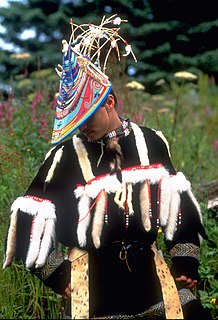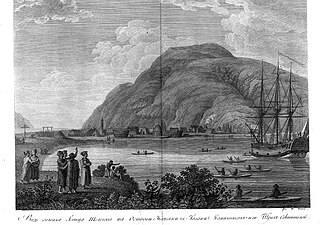
The Yupik are a group of indigenous or aboriginal peoples of western, southwestern, and southcentral Alaska and the Russian Far East. They are related to the Inuit and Iñupiat peoples. Yupik peoples include the following:

Kodiak is the main city and one of seven communities on Kodiak Island in Kodiak Island Borough, Alaska. All commercial transportation between the island's communities and the outside world goes through this city via ferryboat or airline. The population was 6,130 as of the 2010 census. 2018 estimates put the population at 5,968.

Old Harbor is a city in Kodiak Island Borough, Alaska, United States. At the 2010 census the population was 218, down from 237 in 2000.

Chugach, Chugach Sugpiaq or Chugachigmiut is the name of an Alaska Native people in the region of the Kenai Peninsula and Prince William Sound on the southern coast of Alaska. The Chugach people are an Alutiiq people who speak the Chugach dialect of the Alutiiq language.

Alaska Natives or Alaskan Natives are indigenous peoples of Alaska, United States and include: Iñupiat, Yupik, Aleut, Eyak, Tlingit, Haida, Tsimshian, and a number of Northern Athabaskan cultures. They are often defined by their language groups. Many Alaska Natives are enrolled in federally recognized Alaska Native tribal entities, who in turn belong to 13 Alaska Native Regional Corporations, who administer land and financial claims.

The Alutiiq people, also called by their ancestral name Sugpiaq, as well as Pacific Eskimo or Pacific Yupik, are a southern coastal people of Alaska Natives.

Kodiak Island is a large island on the south coast of the U.S. state of Alaska, separated from the Alaska mainland by the Shelikof Strait. The largest island in the Kodiak Archipelago, Kodiak Island is the second largest island in the United States and the 80th largest island in the world, with an area of 9,311.24 km2 (3,595.09 sq mi), slightly larger than Cyprus. It is 160 km long and in width ranges from 16 to 97 kilometers. Kodiak Island is the namesake for Kodiak Seamount, which lies off the coast at the Aleutian Trench. The largest community on the island is the city of Kodiak, Alaska.

The Kodiak Archipelago is an archipelago south of the main land-mass of the state of Alaska, about 405 km (252 mi) by air south-west of Anchorage in the Gulf of Alaska. The largest island in the archipelago is Kodiak Island, the second-largest island in the United States. The archipelago has a length of about 285 km (177 mi) and a width of about 108 km (67 mi), from the Barren Islands on the north to Chirikof Island and the Semidi Islands group on the south. The archipelago contains 13,890 km2 (5,360 sq mi) of land. The Kodiak Archipelago contains about 40 small glaciers, numerous streams and many species of land and marine animals. Much of its land is forested.
The Native Village of Afognak is a federally recognized Alutiiq Alaska Native tribal entity, originally native to the island of Afognak.
Alvin Eli Amason is a Sugpiaq Alaskan painter and sculptor. He was raised in Kodiak and is of Alutiiq ancestry. He received his Master of Fine Arts from Arizona State University and taught for several years at Navajo Community College. For seventeen years, he taught at the University of Alaska Fairbanks and was the head of the Alaska Native Art studies program there. After retiring, he was asked to join the Department of Art at the University of Alaska, Anchorage and develop an Alaska Native Art curriculum.
Sitkalidak Island is an island in the western Gulf of Alaska in the Kodiak Island Borough of the state of Alaska, United States. It lies just off the southeast shore of Kodiak Island, across the Sitkalidak Strait from the city of Old Harbor. The island has a land area of 300 square kilometers (120 sq mi) and no resident population.

A barabara or barabora (Russian); ulax̂, ulaagamax, ulaq, or ulas (plural) (Aleut); and ciqlluaq were the traditional, main or communal dwelling used by the Alutiiq people and Aleuts, the indigenous people of the Aleutian Islands. They lay partially underground like an earth lodge or pit-house, and most of the house was excavated from the dirt so as to withstand the high forces of wind in the Aleutian chain of islands. Barabaras are no longer used, as present-day Aleuts live in modern houses and apartment buildings.
The Alutiiq language is a close relative to the Central Alaskan Yup'ik language spoken in the western and southwestern Alaska, but is considered a distinct language. It has two major dialects:

Sven Haakanson, Jr. (Alutiiq) is an American anthropologist who specializes in documenting and preserving the language and culture of the Alutiiq. He served, from 2000-2013, as Executive Director of the Alutiiq Museum in Kodiak, Alaska. He is employed as Associate Professor by the University of Washington, Seattle, and as Curator of North American Anthropology with Burke Museum. In 2007 he was named as a MacArthur Fellow for being a leader in the effort to rekindle Alutiiq language, customs and culture.

The Awa'uq Massacre or Refuge Rock Massacre, or, more recently, as the Wounded Knee of Alaska, was an attack and massacre of Koniag Alutiiq (Sugpiaq) people in April 1784 at Refuge Rock near Kodiak Island by Russian fur trader Grigory Shelekhov and 130 armed Russian men and cannoneers of his Shelikhov-Golikov Company.

Henrik Johan Holmberg or Heinrich Johann Holmberg was a Finnish naturalist, geologist (mineralogist) and ethnographer. He was the first recorder of the Awa'uq Massacre in the Russian America of Shelikhov-Golikov Company. Henrik Holmberg followed in 1851 to document an evolved origin story and several other stories as told by Arsenti Aminak.

Yup'ik doll is a traditional Eskimo style doll and figurine form made in the southwestern Alaska by Yup'ik people. Also known as Cup'ik doll for the Chevak Cup'ik dialect speaking Eskimos of Chevak and Cup'ig doll for the Nunivak Cup'ig dialect speaking Eskimos of Nunivak Island. Typically, Yup'ik dolls are dressed in traditional Eskimo style Yup'ik clothing, intended to protect the wearer from cold weather, and are often made from traditional materials obtained through food gathering. Play dolls from the Yup'ik area were made of wood, bone, or walrus ivory and measured from one to twelve inches in height or more. Male and female dolls were often distinguished anatomically and can be told apart by the addition of ivory labrets for males and chin tattooing for females. The information about play dolls within Alaska Native cultures is sporadic. As is so often the case in early museum collections, it is difficult to distinguish dolls made for play from those made for ritual. There were always five dolls making up a family: a father, a mother, a son, a daughter, and a baby. Some human figurines were used by shamans.
The Yupiit Piciryarait Cultural Center (YPCC), also known as Yupiit Piciryarait Cultural Center and Museum, formerly known as the Yup'ik Museum, Library, and Multipurpose Cultural Center, is a non-profit cultural center of the Yup'ik culture centrally located in Bethel, Alaska near the University of Alaska Fairbanks' Kuskokwim Campus and city offices. The center is a unique facility that combines a museum, a library, and multi-purpose cultural activity center including performing arts space, for cultural gatherings, feasts, celebrations, meetings and classes. and that celebrates the Yup'ik culture and serves as a regional cultural center for Southwest Alaska. The name of Yupiit Piciryarait means "Yup'iks' customs" in Yup'ik language and derived from piciryaraq meaning "manner; custom; habit; tradition; way of life" Construction of this cultural facility was completed in 1995, funded through a State appropriation of federal funds. Total cost for construction was $6.15 million. The center was jointly sponsored by the Association of Village Council Presidents (AVCP) and the University of Alaska Fairbanks (UAF) and at the present the center operated by the UAF's Kuskokwim Campus, AVCP and City of Bethel. The building houses three community resources: the Consortium Library, the Yup'ik Museum, and the Multi-purpose room or auditorium. The mission of the center is promote, preserve and develop the traditions of the Yup'ik through traditional and non-traditional art forms of the Alaska Native art, including arts and crafts, performance arts, education, and Yup'ik language. The center also supports local artists and entrepreneurs.
Ethnomuseology is the study of museums and museum curation in the context of the culture and cultural traditions of its collections. It is an interdisciplinary field combining museum studies, anthropology, ethnography, and often various fine arts.
Linda Anne Infante Lyons is a Native American visual media artist from Anchorage, Alaska. She is Alutiiq, with her mother's family descending from Kodiak Island, and Estonian. The island's natives experienced two waves of colonization, which plays a central role in Lyons' artwork.












